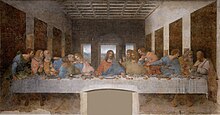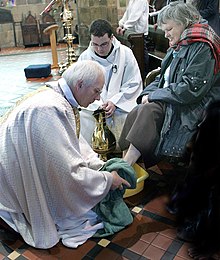Scripture to Read With the Stripping of the Altar on Maundy Thursday


Bishop John washes feet on Maundy Thursday 2007.
The Mass of the Lord's Supper, also known as A Service of Worship for Maundy Thursday, is a Holy Week service historic on the evening of Maundy Thursday.[i] [2] It inaugurates the Easter Triduum,[3] and commemorates the Last Supper of Jesus with his disciples, more explicitly than other celebrations of the Mass.
The Catholic Church, Lutheran Churches, Methodist Churches, Reformed Churches, and Anglican Communion celebrate the Mass of the Lord's Supper (or the Liturgy of Maundy Thursday).[1] [4] [5]
The Mass stresses iii aspects of that event: "the institution of the Eucharist, the institution of the ministerial priesthood, and the commandment of brotherly honey that Jesus gave after washing the anxiety of his disciples."[half dozen]
In Anglicanism, these rites are found in the Book of Common Prayer,[7] as well as in the Anglican Missal.[8] In Methodism, they are constitute in the Book of Worship for Church building and Dwelling house and The United Methodist Volume of Worship. In Lutheranism, the Maundy Thursday liturgy is found in the Lutheran Service Book and Evangelical Lutheran Worship.
History [edit]
The celebration of a Mass in the evening of Holy Thursday began in late fourth-century Jerusalem, where it became customary to gloat the events of the Passion of Jesus in the places where they took place. In Rome at that fourth dimension a Mass was celebrated at which penitents were reconciled with a view to participation in the Easter celebrations. The Jerusalem custom spread and in 7th-century Rome the Pope celebrated a Mass of the Lord'due south Supper on this twenty-four hours every bit well as the Mass of Reconciliation. By the eighth century, the Masses became iii: one for reconciliation, one for blessing the holy oils and a third for the Last Supper. The concluding two were in reduced form, being without Liturgy of the Give-and-take. Pope Pius V's reforms in 1570 forbade the celebration of Mass afterward noon, and the Mass of the Lord's Supper became a morn Mass and remained and then until Pope Pius XII's reforms in the 1950s.[ix]
The washing of feet that is now part of the Mass of the Lord's Supper was in utilise at an early stage without relation to this particular solar day, and was starting time prescribed for use on Holy Thursday by a 694 Council of Toledo. Past the 12th century information technology was establish in the Roman liturgy equally a separate service. Pope Pius 5 included this rite in his Roman Missal, placing it after the text of the Mass of the Lord's Supper.[10] He did not make information technology role of the Mass, but indicated that it was to take place "at a suitable hour" after the stripping of the altars.[xi] The 1955 revision by Pope Pius XII inserted it into the Mass. Current rubrics indicate that the rite is not an obligatory part of that Mass, but rather is something to exist carried out "where a pastoral reason suggests information technology" (Roman Missal, Mass of the Lord's Supper, no. ten).[12]
Structure [edit]
The Mass begins as usual, with the exception that the tabernacle, wherever placed, should exist empty.[13]
In the 1962 Missal (Roman rite), although white vestments and the Gloria in Excelsis are used, this is still Passiontide, so the "Judica me" is omitted at the pes of the altar, the "Gloria Patri" in the Introit and at the end of the Lavabo is omitted, and the Preface of the Cantankerous is used. (The crucifixes, which take been covered during Passiontide, can today be covered with white instead of with violet.)
At the singing of the Gloria in Excelsis Deo, all the church bells may be rung; afterwards, they (along with the organ) are silenced until the Gloria of the Easter Vigil.[14]
The Liturgy of the Word consists of the following readings:
- Exodus 12:one-eight, 11-xiv, a clarification of the original Passover celebration.
- Psalm 115 (116), thanksgiving for beingness saved
- Corinthians 11:23-26, Paul the Campaigner'southward account of what Jesus did at his Final Supper
- John 13:ane-xv, John the Evangelist'south account of how Jesus washed his disciples' anxiety before that meal as an example of how they should treat each other.
Later the homily, which should explain the three aspects of the celebration mentioned above,[fifteen] the priest who is celebrating the Mass removes his chasuble, puts on a linen gremiale (an amice is often used for this purpose), and proceeds to launder the feet of a number of people (usually twelve, corresponding to the number of the Apostles)[xvi]
The recitation of the Nicene Creed is omitted in Anglican, Methodist, Lutheran, and Roman Catholic liturgies for Maundy Th.[17]
There are special formulas in the Eucharistic Prayer to recollect that the Mass of the Lord's Supper is in commemoration of Jesus' Last Supper.
Sufficient hosts are consecrated for the faithful to receive Communion both at that Mass and on the next day, Good Friday. The hosts intended for the Good Friday service are non placed in the tabernacle, as is usual, but are left on the chantry, while the priest says the postcommunion prayer.[18] Then the priest incenses the Blest Sacrament 3 times and, taking a humeral veil with which to hold it, carries it in solemn procession to a place of reservation somewhere in the church or in an appropriately adorned chapel.[19] The procession is led by a cross-bearer accompanied by two servers with lit candles; other servers with lit candles follow and a thurifer immediately precedes the priest.[xx]
On arrival at the altar of repose, the priest places the vessel with the Blessed Sacrament in the tabernacle at that place, leaving the door open. He then incenses it and closes the tabernacle door. Later a period of admiration, he and the servers depart in silence.[21] A plenary indulgence is granted to the faithful, who devoutly recite the Tantum Ergo on Holy Thursday if it is recited in a solemn manner.[22]
The continuation of Eucharistic admiration is encouraged, only if continued after midnight should exist done without outward solemnity.[23] [24] In the Philippines and several other Catholic countries, the faithful will travel from church to church praying at each church'south altar of repose in a practice known every bit Seven Churches Visitation or Visita Iglesia. The Blest Sacrament remains in the temporary place until the Holy Communion role of the Good Friday liturgical service.
Stripping of the Chantry [edit]
On Maundy Thursday, the chancels of churches are traditionally stripped, with the altar often being draped with black paraments, in preparation for Good Friday.[25]
In the Methodist Churches, the chancel is stripped of any decorations, such as flowers and candles.[26] Aside from depictions of the Stations of the Cantankerous, other images, such as the cross, keep to exist veiled in black or purple.[26]
At the conclusion of the Maundy Thursday liturgy in Lutheran Churches, "the altar, lectern and pulpit are left bare until Easter to symbolize the humiliation and barrenness of the cross."[27]
In Anglican Churches, this ceremony is besides performed at the conclusion of Maundy Thursday services, "in which all appointments, linens, and paraments are removed from the chantry and chancel in grooming for Adept Friday."[28]
In the Catholic Church, the form of the Roman Rite in use earlier 1955 had no washing of the feet, which could instead be done in a carve up later anniversary, and the Mass ended with a ritual stripping of all altars, except the chantry of repose, but leaving the cross and candlesticks.[29] This was washed to the accessory of Psalm 21 (Vulgate) (Deus, Deus meus) preceded and followed by the antiphon "Diviserunt sibi vestimenta mea: et super vestem meam miserunt sortem" (They divided my wearing apparel amongst them and cast lots for my garment).[30] In the Catholic Church building, since 1955, the chantry is stripped bare without ceremony later.[31]
References [edit]
- ^ a b "A Service of Worship for Maundy Thursday" (PDF). Cheatham Memorial United Methodist Church. 24 March 2016. Retrieved 23 March 2018.
- ^ Elwell, Walter A. (2001). Evangelical Dictionary of Theology. Baker Academic. p. 750. ISBN9780801020759.
Observed in the Roman Catholic Church building, Maundy Thursday appears on the Lutheran, Anglican, and many Reformed liturgical calendars and is almost universally historic with the Lord's Supper.
- ^ "Full general Norms for the Liturgical Year and the Calendar, nineteen". Archived from the original on 2009-04-eleven. Retrieved 2009-04-17 .
- ^ "The Liturgy of Maundy Thursday". Holy Trinity Lutheran Church building. 17 April 2014. Retrieved 23 March 2018.
- ^ "Maundy Thursday". Reformed Church in America. 2018. Retrieved 23 March 2018.
- ^ Holy Th Evening Mass of the Lord's Supper, 45
- ^ Proper Liturgy for Maundy Thursday, 1979 (American) Book of Common Prayer
- ^ The Anglican Missal, pp. B44-B59
- ^ Orlando O. Espín, James B. Nickoloff, An Introductory Lexicon of Theology and Religious Studies (Liturgical Press, 2007 ISBN 0-8146-5856-3, ISBN 978-0-8146-5856-7), p. 379
- ^ Orlando O. Espín, James B. Nickoloff, An Introductory Lexicon of Theology and Religious Studies (Liturgical Press, 2007 ISBN 0-8146-5856-three, ISBN 978-0-8146-5856-seven), p. 380
- ^ Missale Romanum, Editio Princeps (1570), reproduction published by Libreria Editrice Vaticana 1998, ISBN 88-209-2547-eight
- ^ "Holy Th Mandatum", USCCB, 2016
- ^ Holy Thursday Evening Mass of the Lord's Supper, 48
- ^ Holy Thursday Evening Mass of the Lord's Supper, 50
- ^ Holy Thursday Evening Mass of the Lord'southward Supper, 45
- ^ Holy Thursday Evening Mass of the Lord'southward Supper, 51
- ^ Jr., J. Dudley Weaver (2002). Presbyterian Worship: A Guide for Clergy. Geneva Press. p. 96. ISBN9780664502188.
Some congregations in some traditions omit the creed in the Maundy Thursday liturgy because it is thought of as being besides festive for the occasion. The Roman, Lutheran, Episcopalian, and Methodist liturgies all omit the creed.
- ^ Missale Romanum, Feria 5 in Cena Domini, 35-36
- ^ Missale Romanum, Feria V in Cena Domini, 37-38
- ^ Missale Romanum, Feria Five in Cena Domini, 38
- ^ Missale Romanum, Feria V in Cena Domini, 39-40
- ^ Sacred Apostolic Penitentiary, Enchiridion Indulgentiarum, 2nd ed., 1968
- ^ Missale Romanum, Feria V in Cena Domini, 43
- ^ Holy Thursday Evening Mass of the Lord's Supper, 56
- ^ The Century Dictionary. Century Company. 1911. p. 2378.
The early church observed it as a strict fast; in the church services doxologies were omitted, no music except the most plaintive was allowed, and the altars were stripped and draped in blackness.
- ^ a b Hickman, Hoyt L. (1 July 2011). United Methodist Altars: A Guide for the Congregation (Revised Edition). Abingdon Printing. p. 55. ISBN9781426730696.
- ^ Fakes, Dennis R. (1994). Exploring Our Lutheran Liturgy. CSS Publishing. p. 34. ISBN9781556735967.
- ^ Publishing, Morehouse (2015). The Episcopal Handbook, Revised Edition. Church Publishing, Inc. p. 218. ISBN9780819229564.
stripping of the chantry: Anniversary at the conclusion of the Maundy Th liturgy, in which all appointments, linens, and paraments are removed from the altar and chancel in preparation for Good Friday.
- ^ Herbermann, Charles, ed. (1913). . Catholic Encyclopedia. New York: Robert Appleton Visitor.
- ^ Herbermann, Charles, ed. (1913). . Cosmic Encyclopedia. New York: Robert Appleton Company.
- ^ Roman Missal, Thursday of the Lord's Supper, 41
martinezsherecomare.blogspot.com
Source: https://en.wikipedia.org/wiki/Mass_of_the_Lord%27s_Supper
0 Response to "Scripture to Read With the Stripping of the Altar on Maundy Thursday"
Post a Comment